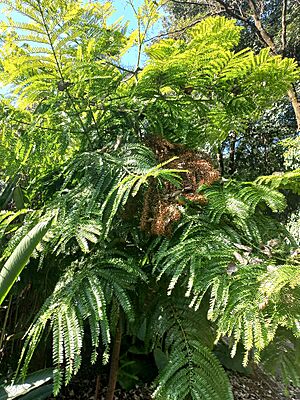Retrophyllum piresii facts for kids
Quick facts for kids Retrophyllum piresii |
|
|---|---|
 |
|
| Conservation status | |
| Scientific classification | |
| Genus: |
Retrophyllum
|
| Species: |
piresii
|
Retrophyllum piresii is a special type of tree called a conifer. It belongs to the Podocarpaceae family, which is a group of ancient trees. This particular conifer is only found in Brazil, making it unique to that country.
Contents
What is Retrophyllum piresii?
Retrophyllum piresii is a fascinating plant. Like all conifers, it usually has needles or scale-like leaves and produces cones instead of flowers. Think of pine trees or fir trees – they are also conifers! This species is part of a very old plant family, the Podocarpaceae, which has been around for millions of years.
Where Does It Live?
This special conifer is endemic to Brazil. This means it naturally grows only in Brazil and nowhere else in the world. Brazil is a huge country with many different types of environments, from rainforests to mountains. Plants like Retrophyllum piresii are often adapted to specific conditions in their native homes.
Why Are Conifers Important?
Conifers play a big role in many ecosystems around the world. They provide homes and food for many animals. Their wood is also very useful for humans, used in building, paper, and other products. Some conifers can live for thousands of years, becoming some of the oldest living things on Earth!
What Does "Data Deficient" Mean?
The conservation status of Retrophyllum piresii is listed as "Data Deficient" (DD) by the International Union for Conservation of Nature (IUCN). This is an important term for scientists and conservationists.
Why is Data Deficient a Concern?
When a species is "Data Deficient," it means there isn't enough information about it to know if it's endangered or not. Scientists haven't been able to study it enough to understand its population size, how fast it's disappearing, or what threats it faces.
What Happens When Data is Lacking?
Without enough data, it's hard to make good decisions about how to protect a species. It could be very rare and close to extinction, or it could be doing just fine. More research is needed to find out the true status of Retrophyllum piresii. This often involves exploring its habitat, counting individual plants, and understanding its life cycle.
Why is Protecting Plants Important?
Every plant species, including Retrophyllum piresii, is part of the amazing variety of life on Earth, called biodiversity. Each species plays a role in its ecosystem.
How Do Plants Help Us?
Plants produce the oxygen we breathe and are the base of most food chains. They also provide medicines, materials, and help keep our planet healthy by absorbing carbon dioxide. Losing even one species can have a ripple effect on the environment.
What Can Be Done?
To protect plants like Retrophyllum piresii, scientists and conservation groups work to:
- Learn more about them through research.
- Protect their natural habitats from being destroyed.
- Educate people about the importance of biodiversity.
By understanding and protecting unique species like Retrophyllum piresii, we help ensure a healthy planet for everyone.


